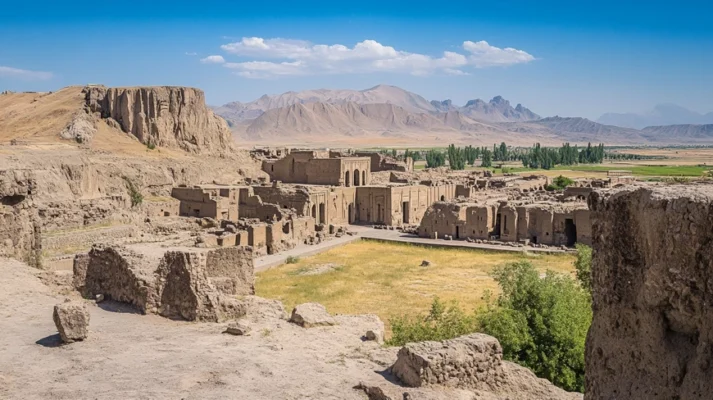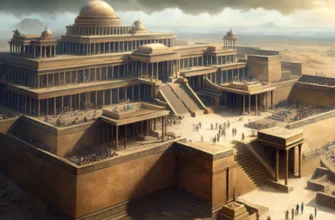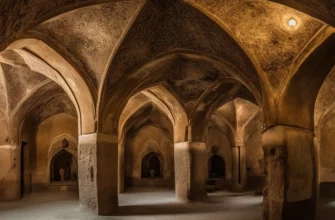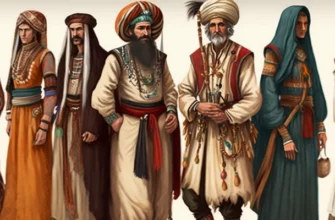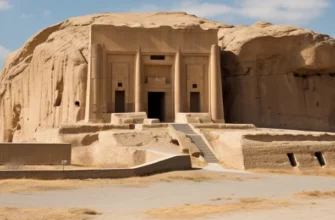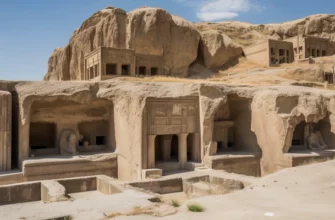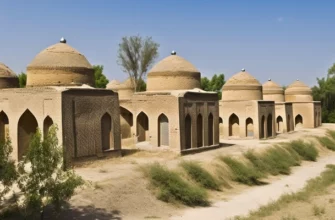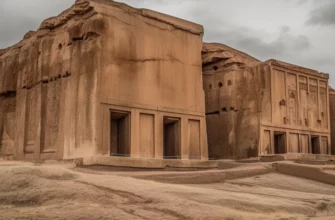Hecatompolis was one of the most important cities of ancient Iran and played a key role in the political and cultural life of the Parthian Empire. Its name, translated from Greek, means “one hundred gates,” which could symbolize its grandeur or its extensive network of city districts. The city was located in modern-day Iran, probably near the present-day city of Damghan. During the heyday of Parthia, Hecatompylos was the capital of the state, an administrative center, and an important hub for trade routes connecting the East and West.
Caravan routes passed through the city, including the Silk Road, which contributed to the active development of trade and crafts. Its wealth and strategic location attracted not only merchants but also rulers and conquerors. Despite its significance, the exact location of Hecatompylos is still a subject of scientific debate.
Archaeological excavations in the probable areas suggest that the city had a well-developed infrastructure with palaces, temples, and residential quarters. As a result of political changes, wars, and the shift of trade routes, Hecatompylos declined and eventually disappeared from the map of active life.
However, its historical role as one of the centers of the Parthian Empire remains important for understanding the cultural and political development of ancient Iran.
The name “Hecatompylos” comes from the Greek Hekatompylos, which means “one hundred gates” (hekaton — one hundred, pylai — gates). This is a generalized poetic or symbolic name, characteristic of the Greek tradition of describing magnificent cities. Such a name indicated not so much the literal number of city gates as the scale, importance, and urban development of the city.
The Greek name appeared as a result of contacts between the Hellenistic world and Iran, especially after the conquests of Alexander the Great. During the Hellenistic period, many cities in the East received new names or translations of their local names into Greek. The exact local name of Hecatompylos before Hellenization remains unknown, but the Greek form became established in historical sources and became common in ancient literature.
- Role in the Parthian Empire
- Archaeological research
- Discovery and excavations
- Major archaeological finds
- Problems with identifying the city
- Architecture and urban planning
- City layout
- Temples, palaces, and fortifications
- Lifestyle and infrastructure
- Cultural and economic significance
- Overall impact on the economy
- Cult of the dead and burial traditions
- The decline of Hecatompylos
- The legacy of Hecatompylos
- Overall impact and significance of the heritage
- Political influence
- Economic influence
- Conclusions
Role in the Parthian Empire
Hecatompylos played a key role in the Parthian Empire, especially in its early stages. In the 3rd–2nd centuries BC, the city became the first official capital of Parthia after its liberation from Seleucid rule. Its choice as an administrative center was due to its advantageous location — at the intersection of trade routes and in the geographical center of the newly formed state, which facilitated effective control over the captured territories.
Hecatompolis became the seat of the royal court, administration, and army. Foreign embassies were received here, intergovernmental agreements were concluded, and coins were minted, which testifies to the city’s high economic and political activity. During that period, it was not only a political but also a cultural center, where Greek, Iranian, and Mesopotamian influences intersected.
Although the capital was later moved to Ctesiphon, Hecatompylos did not lose its importance. It remained an important regional center and strategic point in the Parthian administration until the fall of the empire.
Archaeological research
Archaeological research in Hecatompylos has been ongoing for over a century, but the exact location of the city has not yet been definitively established. Most researchers believe that Hecatompylos was located near the modern Iranian city of Damghan in the province of Semnan. The first serious excavations in this region were carried out in the 20th century, but a significant breakthrough came only with the advent of the latest methods of ground-penetrating radar and aerial photography.
Archaeological research has uncovered the remains of city walls, building foundations, ceramics, and fragments of Parthian coins, confirming that the site dates back to the heyday of the Parthian Empire. Of particular value are traces of urban planning — straight streets, water supply systems, and remains of defensive structures.
Despite this, the archaeological picture remains fragmentary. Destruction by soil, erosion, and modern economic activity complicate research. In addition, the absence of large stone structures characteristic of many ancient cities forces archaeologists to rely on indirect evidence, such as written sources from ancient Greek and Roman authors.
Today, Hecatompylos remains one of the most mysterious cities of ancient Iran, and its archaeological study opens up new perspectives for understanding the urbanization, culture, and politics of the Parthian Empire.
Discovery and excavations
The discovery of the possible location of Hecatompylos took place in the 19th century, when European travelers and explorers, particularly British and French, began to study the Iranian plateau.
They noticed the remains of an ancient city near the modern city of Damghan, particularly in the Shar-e-Kumis area, which could correspond to the descriptions of Hecatompylus given by ancient authors.
The first archaeological surveys in this area were conducted in the mid-20th century, particularly by Iranian and American archaeologists. The most active excavations were carried out by an archaeological mission from the University of Pennsylvania. They discovered the remains of city walls, clay pottery, household items, and coins from the Parthian period, confirming the city’s active life during the Parthian Empire.
Of particular interest were finds that testify to urban planning and infrastructure, such as roads that intersected at right angles and a drainage system. These elements indicate a high level of organization of urban life.
However, due to the absence of large-scale stone structures and significant soil erosion, research was difficult. Political and economic factors also hindered the work, periodically halting fieldwork. Despite this, modern technologies, including satellite imagery and geophysical methods, are opening up new opportunities to continue the study and more accurately identify the city as Hecatompylos.
Major archaeological finds
The main archaeological finds discovered at the site believed to be Hecatompylos (the Shar-e-Kumis area near Damgan) provide insight into the life, structure, and culture of this ancient city. The most significant artifacts fall into the following categories:
- Coins
The discovery of Parthian coins bearing images of rulers helps to date the layers of the settlement and confirms the political status of the city. The coins also indicate the existence of a local mint.
- Pottery
Fragments of pottery—bowls, jugs, amphorae—have been found in various parts of the city. Their style and technique demonstrate both local traditions and the influence of Greek culture.
- Architectural remains
The foundations of residential and public buildings, parts of city walls, and defensive structures have been found.
The layout of the streets and the remains of drainage systems indicate a developed urban infrastructure.
- Tools and household items
Among the finds are stone and metal tools, combs, spindle whorls, and jewelry elements. They allow us to reconstruct the everyday life of the city’s inhabitants.
- Inscriptions and seals
Although few epigraphic materials have been found, individual clay tablets and seals with symbols and inscriptions help to better understand the administrative system and elements of writing at that time.
These finds confirm that Hecatompylos was a major cultural and economic center of the Parthian Empire. At the same time, research continues, and future excavations may reveal even more information about the life of this ancient city.
Problems with identifying the city
The problems with identifying Hecatompylos remain relevant and are still a topic of debate among historians and archaeologists. The main difficulty lies in the fact that the city did not leave behind any monumental structures or clearly marked inscriptions that would unequivocally confirm its name at the excavation site.
Most of the information about Hecatompylos comes from Greek and Roman written sources, such as Strabo, Pliny the Elder, and Ptolemy, who provided general geographical descriptions but without precise coordinates.
Another problem is the presence of several ancient cities in the region that could theoretically match the description of Hecatompylus. For example, the city of Shar-e-Kumis near Damghan has archaeological signs of a large urban center, but there is no definitive confirmation of its identification with Hecatompylus. In addition, there are other sites with similar characteristics in Iran, which creates competition between hypotheses.
The situation is further complicated by the long-term use of urban construction materials by the local population, which has led to the destruction of a significant part of the ancient structures. Erosion, earthquakes, and economic activity have further destroyed the archaeological context.
The lack of epigraphic evidence, insufficient funding for research, and limited access to some sites for political reasons also hinder the process of finally recognizing the site as the real Hecatompylos. Nevertheless, most modern researchers are inclined to believe that Shar-e-Kumis is the most likely candidate for the identification of this legendary city.
Architecture and urban planning
The architecture and urban planning of Hecatompylos testify to the high level of organization and development of urban culture in the Parthian Empire. Although the remains of the city are fragmentary, archaeological data allow us to reconstruct the main features of its structure.
The city had a clear layout, typical of many ancient Eastern centers, with straight streets intersecting at 90° angles and a grid of blocks. This layout not only facilitated movement and defense but also reflected the administrative organization of the space. The royal palace or government complex was probably located in the city center, surrounded by houses of the nobility, temples, and public buildings.
The defensive system consisted of city walls surrounding the main areas, probably with towers and gates, emphasizing the military importance of the city. Since the name “Hekatompylos” literally means “hundred gates,” this may be a symbolic reflection of the large number of entrances to the city or quarters.
Residential buildings had a structure characteristic of Parthia: an inner courtyard around which rooms were grouped. Local materials were used, such as fired and unfired bricks. Remains of a water supply system, including drainage channels, have been found, indicating an understanding of hygiene and comfort.
Researchers pay particular attention to the presence of temple complexes or cult buildings, although their identification remains uncertain. The architecture of Hecatompylos demonstrates a combination of Iranian traditions with Greek and Mesopotamian influences, which is typical of the cultural environment of the Parthian Empire.
Overall, the architecture and layout of Hecatompylos reflect its role as a political, administrative, and cultural center, as well as the high level of urban development in ancient Iran.
City layout
The layout of Hecatompylos was notable for its thoughtfulness and functionality, which corresponded to its status as a major administrative and commercial center of the Parthian Empire. Archaeological research, particularly in the Shar-e-Kumis area, indicates the use of a regular grid plan — a system of straight streets intersecting at right angles and forming distinct quarters.
The central part of the city probably included a government quarter with the palace of the ruler or governor, administrative buildings, and possibly religious structures. Residential areas with houses oriented towards inner courtyards were located around it, ensuring privacy and comfort — a typical feature of Parthian architecture.
The city quarters were connected by main thoroughfares, which not only facilitated movement but also served as trade routes. An important element was the presence of a drainage system and, possibly, canals for water supply, confirming the existence of engineering infrastructure. Defensive structures, including walls and towers, formed the outer contour of the city, protecting it from attacks.
There may have been warehouses, trading areas, craft workshops, and caravanserais on the outskirts of the city to serve travelers and merchants. Such comprehensive planning indicates a high level of organization of urban space, which was capable of ensuring both political governance and the economic life of a large center of ancient Iran.
Temples, palaces, and fortifications
Although archaeological data on Hecatompylos remains limited, existing finds and reconstructions suggest the existence of important public and defensive structures, including temples, palaces, and fortifications, befitting the status of the capital of the Parthian Empire.
Palaces
In the center of the city, there was most likely a palace complex — the residence of the local ruler or the king himself during the period when Hecatompylos served as the capital. Given the characteristics of Parthian architecture, such palaces would have included large inner courtyards, peristyles, reception halls (ayvan), and could have been decorated with plaster, wall paintings, or mosaics. Some of these buildings may also have been used as administrative offices.
Temples
There is currently no direct archaeological evidence of temples in Hecatompylos, but given the religious structure of Parthia, there were probably shrines dedicated to Zoroastrian gods, as well as possible Hellenistic cults common in the region.
Temple buildings may have had elevations (altars), open courtyards for rituals, and been used as centers of public life.
Fortifications
Fortifications are one of the most likely parts of the city’s infrastructure. According to excavations in Shar-e-Kumis, the city was surrounded by a defensive wall, possibly with towers and several entrance gates. This system had a defensive function but also symbolic significance, reflecting the power and stability of the authorities. Given the symbolic name of the city — “one hundred gates” — it can be assumed that the city had numerous entrances or a segmented structure with internal barriers.
Together, these elements formed not only the defensive and administrative structure of Hecatompylos, but also its cultural and religious core, making it the true capital of the Parthian state in both a political and spiritual sense.
Lifestyle and infrastructure
The lifestyle and infrastructure of Hecatompylos reflect the level of urban development during the Parthian Empire and the combination of local traditions with Hellenistic influences.
Lifestyle
The city’s inhabitants belonged to different social strata: from nobles and government officials to craftsmen, merchants, and servants. Residential buildings had a structure typical of that time — an inner courtyard surrounded by living quarters. This layout provided shade and ventilation in the hot climate. Some houses, especially in the central districts, were decorated with paintings or plasterwork, and wealthy residents used metal utensils, jewelry, and clay lamps.
The products of local craftsmen were widely used in everyday life: ceramic dishes, fabrics, and tools. Food was mainly plant-based — grains, fruits, legumes, dates, as well as dairy products and meat. The market was probably an important part of city life, where both local and transit goods were traded.
Infrastructure
The infrastructure of Hecatompylos was well organized. The streets had a regular layout, which facilitated movement and the functioning of the city. Elements of drainage channels have been found, which carried sewage outside the residential areas, indicating the existence of a basic sanitation system.
Water was probably supplied through canals or underground aqueducts (qanats), typical of Iranian cities. This ensured not only domestic needs but also the functioning of gardens, baths, and utility rooms.
The city also served as an important transit point, so caravanserais — special structures for travelers and merchants to rest — could have been built along trade routes. The presence of coin circulation and workshops indicates economic activity and the existence of a complex exchange system.
Thus, the everyday life and infrastructure of Hecatompolis illustrate the high level of urban development in Parthia, where functionality, convenience, and traditions inherited from previous civilizations were combined.
Cultural and economic significance
As one of the important centers of the Parthian Empire, Hecatompylos had great cultural and economic significance, which influenced the development of this region from the 3rd century BC to the 2nd century AD.
Cultural significance
Hecatompylos was an important cultural center where various civilizations intersected, including Iranian, Greek, and Mesopotamian influences. After the conquests of Alexander the Great, a great cultural exchange took place in Parthia between Hellenistic traditions and local Iranian ones, which was reflected in architecture, art, and religious practices. The city was probably a center for the development of Zoroastrian religion and cults, which intertwined with Greek religious traditions and cults, contributing to the formation of a unique cultural identity.
Hecatompylos was also a place for the preservation and transmission of knowledge. The presence of temples and administrative centers probably meant the development of scientific and philosophical discussions. Scholars, philosophers, and religious figures may have resided in the city, contributing to cultural exchange and the development of education.
Economic significance
Hecatompolis was of strategic economic importance due to its location on important trade routes connecting the West and the East. The city was a key point for the transit of goods such as spices, silk, precious metals, fabrics, and other resources, which contributed to the development of the economy not only of the Parthian state but also to trade with Rome, India, and China.
The city’s economic activity is confirmed by the coins found, which indicate the functioning of a local mint. In addition, developed crafts such as metallurgy, weaving, pottery, as well as organized markets and warehouses for storing goods contributed to the prosperity of the economy.
The city also played a role in the production and storage of grain crops, which was necessary to meet the needs of both the local population and the army. As a result, Hecatompylos became an important hub in the economic and trade relations of the Parthian Empire.
Overall significance
Hecatompylos was an important cultural and economic link in the Parthian Empire, contributing to the development of its political, religious, and economic systems. The city brought together diverse cultural traditions, creating a special atmosphere for intellectual and religious development. Its economic importance, particularly thanks to its trade routes and role in international exchanges, was also significant for the stability and prosperity of the Parthian state.
Trade and crafts
Trade and crafts were the main components of the economic life of Hecatompylos, contributing to its prosperity as an important commercial and economic center of the Parthian Empire.
The city was located on important trade routes, which gave it strategic importance for intercontinental trade, as well as the presence of developed craft traditions that supported the economic stability and self-sufficiency of the city.
Trade
Hecatompolis was an important point on the Silk Road, a trade route connecting the East and West. Goods from India, China, Rome, and other parts of the world passed through this city. Spices, silk, precious metals, fabrics, and handicrafts were particularly valuable.
International trade
Hecatompylos was a key center for the transportation and exchange of goods between different cultures. The influence of Rome and Greece in the form of goods, cultural exchanges, and even stylistic elements in architecture and crafts could be seen in Hecatompylos. Coins in circulation indicate active trade with Rome, where the Parthian Empire had both competitors and allies.
Local trade
In addition to international trade, Hecatompylos had a well-developed market for local goods. Among the local goods sold at the market were grain, fruit, leather, and other handicrafts. The remains of warehouses and trading areas indicate a large turnover of goods in the city.
Trade with other countries
In addition to traditional trade routes, Hecatompolis had ties with India, Central Asia, and China, allowing it to be part of the great economic exchanges of the ancient world. Goods transported through Hecatompolis could include spices, dyes, fabrics, jewelry, and metals.
Hecatompylos was also known for its developed craft traditions, which not only met the city’s internal needs but also contributed to its role as a trading hub.
One of the main crafts was the production of metal goods, such as tools, weapons, jewelry, and ornaments. The Parthian Empire was famous for its metallurgy, and metal goods from Hecatompylos were probably sold on the market and exported to other countries.
Pottery and textile production were also important crafts. Fragments of pottery used for food storage, as well as fabrics and clothing produced by local craftsmen, testify to the high quality of the products that Hecatompylos could export.
Jewelry made of metals and precious stones occupied a special place. Parthian craftsmen made exquisite jewelry that was popular throughout the empire and beyond. The techniques used to make these items influenced the development of jewelry in other cultures, particularly in Rome and India.
Hecatompylos was known for its ceramics — tableware, amphorae, and jugs used for everyday needs. Ceramics from Hecatompylos had styles characteristic of that time, which had both local and foreign influences.
Overall impact on the economy
Thanks to its active trade and developed craft industry, Hecatompylos became an important economic and trade hub of the Parthian Empire, ensuring its prosperity and stability. The trade routes that passed through the city facilitated the exchange of not only goods but also ideas, cultural achievements, and technical innovations that influenced the development of other regions.
Religion and traditions
The religion and traditions of Hecatompylos reflected the richness of the cults and beliefs characteristic of the Parthian Empire. As an important cultural and religious center, Hecatompylos was a place for the spread of religious ideas and practices that combined local Iranian traditions with influences from Hellenistic culture that had penetrated through contact with Greek and Roman cultures.
Zoroastrianism
The main religion that dominated Hecatompylos was Zoroastrianism, a religion based on the teachings of the prophet Zoroaster (Avesta). Zoroastrianism was the state religion of the Parthian Empire, and Hecatompylos, as one of its main capitals, was probably a center of worship for the main deities of this cult, in particular Ahura Mazda, the god of light and goodness. Temples dedicated to Ahura Mazda and other gods may have been located in the city, although archaeological evidence for this remains limited.
Deity worship and sacred fires
One of the main practices in Zoroastrianism was the ritual worship of fire, which was considered sacred. The hearths where religious rites were performed may have been important elements in the religious life of Hecatompylos. Temple complexes probably contained fire altars where offerings were made and sacrifices were brought to the deities. The tradition of maintaining sacred fires and the cult of fire were important to religious practice in the city.
Other religious influences
In addition to Zoroastrianism, other religious influences may have existed in Hekatompylos, particularly Greek-Hellenistic cultures. After the conquests of Alexander the Great and during the Hellenistic period, the cult of Greek deities and philosophical movements became widespread in the region. It is possible that there were temples dedicated to Greek gods such as Zeus, Apollo, or Artemis in Hecatompylos.
At that time, Parthia, although remaining strong in the Zoroastrian tradition, was not completely cut off from other religious systems, and there were mutual influences between the traditions of Parthia, Rome, and other civilizations. For example, worship of Greek deities may have been popular among the elite classes, who interacted actively with the Greeks and Romans.
Cult of the dead and burial traditions
Burial rites also played an important role in the religious practices of Hecatompylos. Zoroastrians believe in the afterlife journey of the soul, and burial traditions included the creation of special places for the dead, such as burial mounds or towers of silence, where bodies were left in the open air for natural decomposition, which was associated with the teachings of purity and purification.
Religious holidays were an important part of social life in Hecatompylos. In particular, celebrations of important religious events, such as the birthday of Zoroaster, could be held in large squares, where prayers, sacrifices, and sacred rites were performed, gathering large numbers of people. Interaction with other cultures, particularly through trade routes, also contributed to the exchange of festive and religious traditions.
As a major commercial and cultural center, Hecatompolis became a place of religious and cultural syncretism. Various beliefs and practices met here, influencing the lives of local residents. The combination of Zoroastrian traditions with Hellenistic and even Roman influences helped to create a unique religious atmosphere that contributed to the cultural development of the city.
Thus, the religion and traditions of Hecatompylos were multifaceted, combining Zoroastrianism, fire worship, Hellenistic religions, and Roman influences, which emphasized the city’s important role as a religious and cultural center in the Parthian Empire.
The decline of Hecatompylos, like many other ancient cities, was linked to a number of political, economic, and social factors, as well as military conflicts that took place in the Parthian Empire. The city gradually lost its importance, but its legacy survived for many centuries, leaving a significant mark on history.
The decline of Hecatompylos
Military conflicts
One of the main reasons for the decline of Hecatompylos was the intervention of other empires in the affairs of Parthia. The city was under pressure from Roman troops, who repeatedly invaded Parthian territory. In addition, in the middle of the 2nd century AD, the Parthian state was going through a period of political instability and internal conflicts, which also affected the economic and cultural life of the city.
The pressure of neighboring states
Neighboring tribes, such as the Sassanids, gradually gained strength and gained control over the territory of Parthia. Hecatompylos, as an important city, became a target for their attacks. Ultimately, in the 3rd century AD, the Sassanids, who had captured most of Parthia, may have been responsible for the final decline of Hecatompylos.
Economic problems
The decline of the city was also due to economic difficulties caused by constant wars and changes in trade routes, which affected the stability of the local economy. The city lost its role as an important trading hub, and its economy could no longer sustain the prosperity of previous times.
The legacy of Hecatompylos
Although Hecatompylos lost its importance as a political and economic center, its cultural heritage was preserved in numerous archaeological finds and historical documents.
The city became an example of how different cultures can mix and coexist. Zoroastrianism, Hellenistic influences, and Roman elements left a significant mark on religious practices, art, and architecture.
Archaeological heritage
Excavations in Hecatompylos have uncovered numerous architectural monuments, such as palaces, temples, fortifications, and residential buildings, which provide insight into life in this city. Finds of pottery, coins, jewelry, and household items are important evidence of the economic activity and craftsmanship of Hecatompylos.
Influence on subsequent civilizations
The legacy of Hecatompylos was reflected in the culture and politics of subsequent states, particularly the Sassanid Empire, which inherited many aspects of Parthian culture and administrative traditions. Hecatompolis left behind an important cultural legacy, especially in the fields of architecture and urban planning, which was adopted by subsequent civilizations in the Middle East.
Revival through research
The decline of Hecatompylos does not mean that it has been completely forgotten. Archaeological research conducted on its ruins is allowing part of its history and cultural significance to be restored. This revival of interest in Hecatompylos also contributes to a better understanding of the development of the Parthian Empire and its interaction with other civilizations.
Overall impact and significance of the heritage
The decline of Hecatompylos was the result of a number of complex factors, but the city’s heritage lives on through archaeological research and cultural recognition. Hecatompylos has become an important symbol for understanding the development of the Parthian Empire and its interactions with other cultures.
Its cultural, economic, and religious practices have been preserved in monuments that help reconstruct the ancient history of this important city.
Impact on the further history of Iran
Hecatompolis had a significant impact on the further history of Iran, as this city, being an important center of the Parthian Empire, left its mark on the development of culture, politics, and economy, and also influenced the subsequent states of Iran. As part of the Parthian Empire, Hecatompylis played a key role in shaping Iranian identity and political structures, which persisted even after its decline.
Political influence
Transition to the Sassanid Empire
After the decline of the Parthian Empire in the 3rd century AD and the arrival of the Sassanids, many elements of the political and administrative organization that existed in Hecatompylos and other Parthian cities were inherited by the new empire. For example, the Sassanids continued to use many aspects of the Parthian administrative system, particularly in the organization of territorial administration and military strategy. As an important center, Hecatompylos became one of the models for the new state, which sought to consolidate its power in the east and drew on the experience of previous rulers.
Religious influence
Zoroastrianism, which was the main religion of the Parthian Empire, continued to dominate during the Sassanid Empire. The traditions and practices associated with fire worship and Zoroastrian holidays were inherited by the Sassanids. The city of Hecatompylos, which became an important religious center of Parthia, probably had a significant influence on the formation of the religious policy of the Sassanids, who actively supported Zoroastrianism as the state religion.
Cultural influence
Preservation of cultural heritage
The cultural exchange that took place in Hecatompylos created a unique synthetic culture that combined elements of Zoroastrianism, Greek and Roman culture, as well as influences from other regions. This cultural heritage has been preserved in architecture, art, and crafts, which later became important for Iranian identity. After the decline of Hecatompylos, the Sassanids preserved many cultural elements, adapting them to their needs. In this context, Hecatompylos became an important factor in the further development of Iranian culture.
Art and architecture
The architectural elements found in Hecatompylos became important models for Sassanid architects. For example, the palaces, temples, and fortifications preserved in Hecatompylos served as prototypes for the construction of large Sassanid cities such as Ctesiphon.
The patterns and motifs in the art of Hecatompylos also influenced the further development of Iranian art, particularly in the fields of jewelry and pottery.
Economic influence
Trade routes and economy
Located on important trade routes, Hecatompylos contributed to the development of intercontinental trade, particularly between Rome, India, China, and Parthia. After the decline of Hecatompylos, the trade routes continued to exist and became important for the Sassanids, who preserved many of the trade routes passing through Iran. This contributed to the economic development of the Sassanid Empire, which continued to be an important trading hub between the East and the West.
Crafts and industry
The craft traditions that emerged in Hecatompylis also influenced the development of crafts in Sassanid Iran. Jewelry, pottery, weaving, and metallurgy, which flourished in Hecatompylos, became the basis for the development of similar industries in the Sassanid Empire. The Sassanids actively supported the development of crafts and industry, particularly in cities that inherited the cultural heritage of Parthia.
Preservation of heritage
After the fall of Parthia and the decline of Hecatompylos, its cultural heritage was not forgotten. Archaeological finds from Hecatompylos, which contain elements of Parthian culture, continued to influence the development of Iranian architecture, art, and religion during the Sassanid Empire.
Many elements of this heritage have been preserved in monuments that became the basis for the development of Iranian culture in the following centuries.
Overall influence
As an important center of the Parthian Empire, Hecatompylos had a significant influence on the further history of Iran. Its cultural, political, and economic achievements laid the foundation for the development of the Sassanid Empire, which continued much of what had been started in Hecatompolis. The city became a symbol of cultural syncretism and a bridge between East and West, contributing to the preservation and development of Iranian civilization in the following stages of its history.
Conclusions
Hecatompylos, a city of ancient Iran, left an important mark on the history of the Parthian Empire and the further development of Iran. Its cultural, economic, and religious heritage continued to influence neighboring civilizations and has been preserved through archaeological finds and cultural exchange that took place due to its strategic location.
Hecatompylos became an important center where different cultural traditions, including Zoroastrianism, elements of Greek culture, and Roman influences, came together. This contributed to the development of a unique cultural atmosphere that was reflected in architecture, art, and religious practices. The city played an important role in the administrative and political life of the Parthian Empire, and its legacy was inherited by subsequent states, notably the Sassanids. Elements of the Parthian administrative system and military strategy remained important for subsequent Iranian empires.
Thanks to its location on trade routes, Hecatompylos was an important trading center. The trade routes that passed through the city continued to influence Iran’s economy when, after the city’s decline, the Sassanid Empire maintained these routes and promoted trade. Excavations at Hecatompolis have provided important data for understanding the history of Parthia and its culture. Architectural monuments, household items, and coins allow us to reconstruct life in the city and confirm its importance as a cultural and economic center.
Although damaged by military conflicts and the city’s decline, the heritage of Hecatompylos has been preserved through archaeological research, which is helping to restore knowledge about this important period in Iranian history. The cultural and religious heritage that emerged in Hecatompylos influenced the further development of Iran, particularly the Sassanid Empire, which inherited many aspects of Parthian culture. Overall, Hecatompylis is an important stage in the history of Iran, which became the basis for the development of cultural, political, and economic processes in subsequent periods. Its legacy has become part of Iran’s rich history and continues to influence the modern understanding of the ancient culture of this region.
